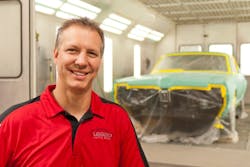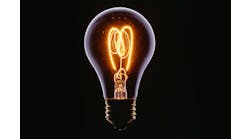Coca-Cola is a prime example, Tim Leland says. McDonald’s, Google, Target, Ford, Apple—they’re all iconic companies with reputations built on recognizable, well-orchestrated branding efforts.
“You see a logo like Coca-Cola, and it makes you think of your whole [experience] with them,” Leland says. “That’s the way it’s going to be, good or bad.”
And that’s what ran through Leland’s mind in mid 2012, as his collision repair facility was about to begin a complete transformation.
For eight years, Leland built Bay 2 Bodyworks from a small, one-man dealership-recondition shop into a $400,000-a-year operation, bursting at the seams of its 1,850-square-foot facility in Bloomington, Minn.
He did it largely on the strength of his reputation and quality of work, but, now, Leland was looking for his business to take the next step—while he took a step into the background.
He had a plan: At the end of 2012, the business would move into a new building, more than four times the size of his previous one, allowing it to accommodate a broader (and significantly larger) customer base. He’d give the business a total makeover, from repair processes to the way it appeared to passersby.
But there was one major road block still standing in the way, spelled out in big block letters across the front door: the shop’s name.
“Our name, and our branding, just wasn’t going to distinguish us enough,” Leland says. “Branding is so important, and ours didn’t say anything about us. We needed something that was going to help us stand out as we grew. We had to make a change.”
The Backstory
Leland jokingly considers himself a jack-of-all-trades, and a master of none. He was first on a shop payroll at age 12 in his father’s Duluth, Minn., facility, and Leland has held virtually every position available in the collision industry since, from sweeping floors to working as a paint distributor.
A bout with cancer in 2003 forced him to take some time off, though, and as he slowly regained his health, he began to perform collision work out of his garage. As a steady supply of family- and friend-based referrals led to a large list of clients, Leland shifted his work into a one-bay, rented space in 2004.
Leland kept growing the business, and by the time he set a course for expansion in 2012, he had five employees working on roughly 25 cars per week.
The Problem
He didn’t put much thought into it at first, other than simply the way it sounded: “‘Bodyworks’ just has a good ring to it,” Leland says.
So, that’s the name he put on the shop’s front door. When, a few months after opening, Leland realized there were several other businesses operating under the Bodyworks name in Minnesota, he simply threw the “Bay 2” in front of it.
“Honestly, I never liked the ‘Bay 2’ part of it, and always thought of us as ‘Bodyworks,’” he says. “But it was the opposite for everyone else. Everyone just called us ‘Bay 2.’ It kind of bugged me.”
The name itself, which was a reference to the second bay Leland took over in his building, meant very little—especially to customers, insurers and vendors who were often confused whether it referenced a second facility.
For Leland, though, it didn’t matter, because his customer base was built almost entirely on word-of-mouth referrals, his one-on-one interactions with the people that came in his shop. And he already had more work than the shop could handle.
But when the business moved into its new facility, Leland knew that had to change.
“We have a lot of competition in our area, and we need to stand out,” Leland says. “We were going to have to start doing much more marketing, try to get bigger relationships with insurers. Our name and brand wasn’t going to do that for us.”
The Options
The criteria was pretty simple: Leland wanted a new name that would be easy to remember, that could lend itself to a simple, memorable logo, and that wasn’t already in use by another shop. Every time he came across a new idea, he jotted it down.
With a list of about 15 possibilities, he started to whittle his options down, eventually coming to two names: Advent Auto Body, and Legend Auto Body.
What’s In a Name?
Tom Zoebelein, president, Stratosphere Studios
If you’re changing your shop’s name or coming up with a name for a new shop, one of the biggest things to think about is memorability. A name like Fix Auto is pretty clever—it’s easy to remember and gives customers an impression about what they do. Legend Auto Body gives a good mental picture to customers, too. You need something that sets you apart from competition. You can’t have any confusion with other shops in your area, or you could be losing customers without the customers even realizing it. Differentiate your business and think about the way the customer will perceive that name.
The Decision
Leland didn’t take the choice lightly. He asked his customers, his employees, local insurers and parts vendors for their thoughts on the name. He tried the names out in different hand-sketched logos, with various color schemes, and showed them around.
“I wanted it to seem different to people but also have a certain level of familiarity,” he says. “I really wanted to brand it. I wanted it to look like a collision shop, and not have a racecar feel or street rod feel to it like some do. I didn’t want it to be super modern or upscale looking. I wanted it to say, ‘Everyone’s welcome.’”
In the end, Leland decided on Legend Auto Body, based on a sketch he made of the company name with a red, side-view outline of a Porsche 911 Carrera surrounding it.
A Sharper Image
Danny Sanchez, president, Autoshop Solutions
A logo should tell people what you do; you shouldn’t even have to read the words to understand what the company is all about. You don’t have the marketing horsepower like Starbucks does to have a logo that needs to be explained. That being said, it had to be created with your audience in mind. You need to understand your target market—if you’re in a rural area and work mostly on trucks, don’t have an image of a European vehicle or sports car in it. The more recognizable it is, and the more it is focused on your audience, the more effective it’ll be.
“It fit the message I wanted about my shop,” he says. “It’s not a futuristic car, but it’s a high-quality one that’s pretty recognizable. It was kind of a tasteful thing.”
The name and the logo would lend itself nicely to all of the marketing efforts Leland had in mind, too. Whether on the sign outside the building or on staff uniforms, it would provide a simple, easy-to-remember brand, he says.
“There wasn’t another shop in the state with that same name, and it was very different than all my competitors around me,” Leland says.
The Aftermath
Leland started transitioning his business to the new facility last October. It was a slow process, as the building wasn’t set up for collision repair.
During the transition, Leland began marketing his shop under the Legend Auto Body brand.
He put up signs at the old building (which hadn’t yet been rented out), telling anyone driving by of the move. He then overhauled the company’s website, complete with an explanation of the name and location change. His estimator, who doubles as the business’s “IT guy,” keeps the page up-to-date and manages the shop’s social media pages. And because there are no other shops with the Legend Auto Body name in Minnesota, the shop’s search engine optimization automatically improved drastically.
In a more proactive strategy, Leland and an employee, who used to work in the insurance industry, did outside sales calls. They stopped by local businesses and insurance offices to introduce themselves and spread the word about the business change. They handed out notepads, pens and other items with the Legend logo on it.
Consistent Branding
Tom Zoebelein, president, Stratosphere Studios
Whatever logo you do have, it needs to be consistent across all your branding. This is why you need to think about how your logo will look on shirts, letterhead, business cards and various marketing materials. You need to be able to have a logo that can work on both dark and light backgrounds, or have an alternate logo. The biggest thing is having it be consistent and easily recognizable. You have to find a brand image that fits your company and fits your culture.
“We wanted to explain in person, especially to some insurers, that we were a whole new shop now at a new location and a whole different business model,” Leland says.
The “value” of his new shop’s work was the focus in all the marketing pieces, he says. In his new space, he created a linear repair process that allowed his staff to get repairs done quicker and more efficiently than in the past. That helps with profitability, Leland says, as does his affordable rent payment.
“We know there are a lot of people with high deductibles who might not want to even file a claim,” he says. “We want to be an affordable option that can do a great repair and get their car back quickly.”
Within the first few months, car count doubled, coming in above 50 cars per week. At the shop’s current pace, Leland expects sales to be just above $1 million for the first 12 months that the new facility was operational.
The Takeaway
The sales and car count, Leland feels, are proof that the marketing is paying off for the business. That growth, all coming with Leland working in more of a supervisory role rather than in one-on-one interactions with customers, shows that the branding has been effective.
“I feel that we have something that people can recognize now,” he says. “They can hear the name and think of us, and it’s evident by the amount of referrals we always get.
“It’s an awful lot of hard work to change your business, whether you’re just moving it or completely redoing things. … Having the name change, and the new branding, it makes sure that it pays off, and that we didn’t just waste our time. We now have something here that we can continue to grow.”





